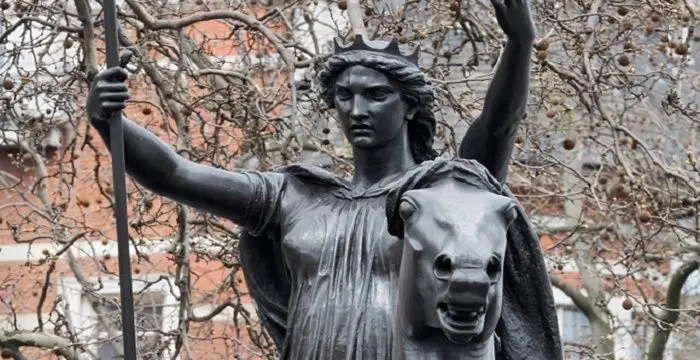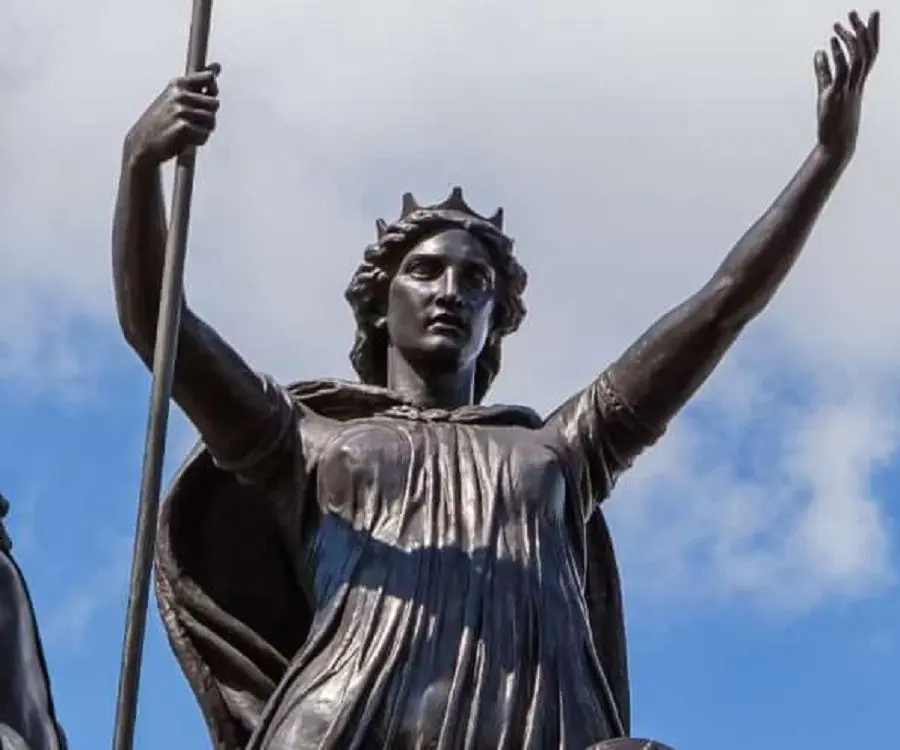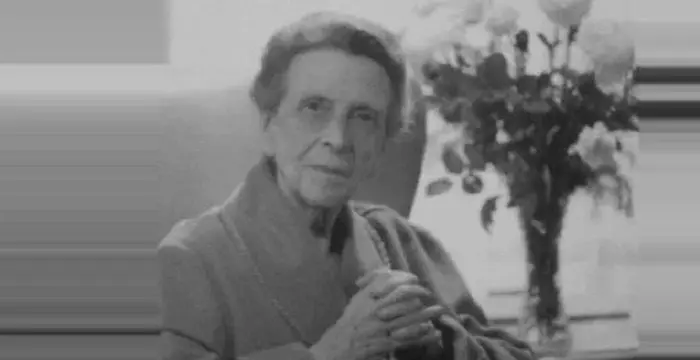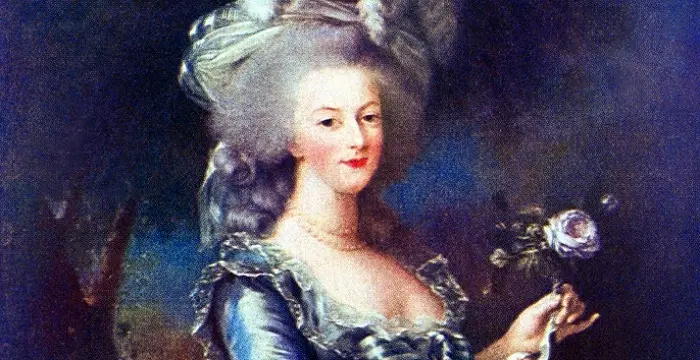
Boudica - Queens, Birthday and Personal Life
Boudica's Personal Details
Boudica was a queen of the Celtic Icenic tribe, who led an uprising against Roman invaders
| Information | Detail |
|---|---|
| Birthday | 30 |
| Died on | January 1, 1961 |
| Nationality | British |
| Famous | Historical Personalities, Empresses & Queens, Empresses, Queen of the Iceni Tribe, Queens |
| Spouses | Prasutagus |
| Known as | Bunduca, Voadicia, Boadicea, Boudicca |
| Birth Place | Britannia |
| Gender | Female |
| Born in | Britannia |
| Famous as | Queen of the Iceni Tribe |
| Died at Age | 31 |
Boudica's photo
Who is Boudica?
Boudica was a queen of the Celtic Icenic tribe, who led an uprising against Roman invaders. Her husband Prasutagus, King of Iceni tribe, was permitted to reign as a nominally independent ally of Rome. In his will Prasutagus named his two daughters and the Roman emperor as co-heirs to his kingdom, however following his death his property was confiscated and his kingdom was annexed. While Tacitus wrote that Roman soldiers lashed Boudica and raped her daughters, Cassius Dio mentioned that earlier regal donations were seized and the Roman financiers called in their loans which led to the revolt. Boudica united different revolting tribes including Iceni and Trinovantes and first destroyed Camulodunum (present-day Colchester) an insignia for Roman rule that housed a temple to the former Emperor Claudius. Her forces then destroyed the commercial settlement of Londinium (present-day London) and Verulamium (present-day St Albans) but were finally defeated by a Roman army led by Gaius Suetonius Paulinus at the Battle of Watling Street. While some sources mention Boudica poisoned herself to death to avoid being captured, some others say that she succumbed to illness.
// Famous Empresses
Jetsun Pema
Jetsun Pema is the Queen consort of Bhutan. Check out this biography to know about her childhood, family life, achievements and fun facts about her life.
Princess Alice of Battenberg
Princess Andrew of Greece and Denmark, also known as Princess Victoria Alice Elizabeth Julia Marie of Battenberg, was the mother of Prince Philip, Duke of Edinburgh and mother-in-law of Queen Elizabeth II. This biography profiles her childhood, famil
Marie Antoinette
Marie Antoinette was the Queen of France and Navarre from 1774 to 1792. who played a major role in provoking the French Revolution. This biography of Marie Antoinette provides detailed information about her childhood and life
Childhood & Early Life
There is very little information available on early life of Boudica and that too comes from extant sources of ancient Roman senator and historian Tacitus and Roman statesman and historian Cassius Dio. Boudica is considered to be born in 30 AD, in Camulodunum in Britannia.
According to sources she was trained as a warrior similar to other Celtic women. She received training in different techniques of fighting and use of weapons.
Both Tacitus and Cassius Dio suggested that Boudica hailed from a royal family. She was described by Dio as a very tall woman with thick and long reddish-brown hair that hanged below her waist. Dio mentioned that she had a harsh and loud voice and one would feel being stabbed by her piercing glare. He said that she always wore a colourful tunic and a flowing tartan cloak that was attached with a brooch while a large golden torc adorned her neck.
Circumstances Leading to the Uprising
Boudica was Queen of Iceni through her marriage with Prasutagus, king of the British Celtic tribe Iceni during 1st century AD. The tribe was inhabitants of the area that more or less constitute present-day county of Norfolk in East Anglia, England.
Prasutagus was either among the 11 kings who surrendered to Roman Emperor Claudius after the Roman conquest of Britain that began effectively in 43 AD or he was made king after a rebellion of the Iceni in 47 AD was put down.
The Iceni tribe became an ally of Rome and Prasutagus was permitted to reign his kingdom, although as a nominally independent king. He made a will naming his two daughters and the Roman Emperor as the co-heirs, which Tacitus felt was an act of deference by the king to ensure protection of his household and kingdom.
Tacitus mentioned that Prasutagus led a long and prosperous life, however following his death, his will was disregarded by the Romans who took over and pillaged the kingdom including confiscating lands of leading Iceni men. Tacitus added that Boudica was flogged by Roman soldiers while her daughters were raped. According to Tacitus these circumstances led to the uprising.
A different account was however suggested by Cassius Dio that led to the revolt. He partly blamed the uprising on “rapacity” of the procurator of Roman Britain in AD 60 or 61, Catus Decianus who confiscated sums of money given to leading Britons by Claudius, declaring them as loans which were to be paid back with interest.
The other reason cited by Dio was the forceful loan given by Roman financier and philosopher Seneca the Younger to the reluctant Britons following Claudius's conquest of Britain in pursuit of getting good rate of interest and then suddenly calling them back all at once and resorting to aggressive measures to get them.
It remains unspecific as to who sent the centurions to plunder the kingdom as also the name of those centurions. It is also not known whether such actions were approved by the then governor of Britain, Gaius Suetonius Paulinus, who was at that time fighting in North Wales.
The Uprising Led by Boudica
During AD 60 or 61, as Paulinus was busy making an assault on the island of Mona (present-day Anglesey), the Iceni tribes along with their neighbours, the Trinovantes and others staged a revolt. They selected Boudica as their leader.
According to Tacitus, the Queen addressed her army saying that she is not avenging the loss of freedom, her flogged body and rape of her daughters as a woman hailing from a noble ancestry but as one among the people. She also said that this is a resolve of a woman to either win or die and as far as the men are concerned they may choose to live in slavery.
The first target of Boudica’s army was Camulodunum that earlier remained capital of Trinovantian but evolved as a Roman colonia by that time. A temple to the former emperor Claudius was constructed there at the expense of the locals who were mistreated by the settled Roman veterans. Although reinforcements were called upon by the Roman settlers, only two hundred auxiliary troops were sent by the then procurator, Catus Decianus. The rebels thrived in destroying Camulodunum which was later shown by the Archaeologists as a methodical demolition.
Quintus Petillius Cerialis who was at that time commanding the Legio IX Hispana (Ninth Iberian Legion) tried to relieve the destructed city but as his troops approached the besieged colonia, they faced severe defeat in hands of Boudica’s army in the Battle of Camulodunum. The casualties included perhaps 80% of the Roman foot-soldiers and only Cerialis and the cavalry managed to flee to a fort nearby.
As Suetonius heard news of fall of Camulodunum, he hastened to reach the next target of Boudica’s army, Londinium, and marched there along the Roman road of Watling Street. Londinium was founded following the 43 AD Roman conquest and the new settlement eventually developed as a flourishing commercial centre.
Suetonius however judged that his troop will be outnumbered by the rebels in defending Londinium and thus decided to sacrifice the city in order to save the province and ordered an evacuation. The city was duly destroyed by Boudica’s army.
The third target of the rebels was the town of Verulamium which suffered the same fate as faced by Camulodunum and Londinium. Around 70,000 to 80,000 Romans and British were considered to have been killed in these three places as a result of such attacks.
Battle of Watling Street & End of the Uprising
As Boudica’s army continued with their attack on Verulamium, Suetonius amassed forces of around 10,000 men including some detachments of the XX Valeria Victrix, and other auxiliaries available apart from Legio XIV Gemina that was under his command. Although outnumbered heavily compared to the rebel forces which according to Dio was around 2, 30,000 at that time, the Romans stood their ground under Suetonius.
The battle occurred at an unidentified location in a defile, possibly somewhere along the Roman road presently called the Watling Street in West Midlands. Although the Britons were large in numbers, the narrowness of the field restricted Boudica to put forth more forces than the Romans at a given time.
While the Romans were skilled to fight in open combat because of their advanced equipment, tactics and discipline, the Britons lacked flexibility and open-field tactics. The Romans progressed in wedge formations smashing through the Briton lines killing thousands. The Britons tried to escape but were impeded as they had kept their own families in a ring of wagons that were placed at the edge of the battlefield.
The Romans had a decisive victory in the war that marked end of resistance to Roman rule in Britain in its southern half till 410 AD. Tacitus said that according to a report around 80,000 Britons were killed compared to death of only 400 Romans.
Death & Legacy
In his book ‘De vita Iulii Agricolae’ (The Life of Agricola) written in 98 AD Tacitus attributed the end of the uprising to socordia ("indolence") and did not mention anything on Boudica’s suicide, however in his other book titled ‘Ab excessu divi Augusti’ (Annals) written in 117 AD, he said that the Queen poisoned herself to death. According to Dio, Boudica died of illness and received an extravagant burial. Historical sources reveal nothing on the ultimate fate of her daughters.
Although there is no evidential proof, it is regarded that Boudica was interred between platforms 9 and 10 in London’s King's Cross station. She found place in several literary works like ‘Chronicles’ (1577) by Raphael Holinshed; ‘Bonduca’ (1610) by Francis Beaumont and John Fletcher; and ‘Boadicea, an ode’ (1782) by William Cowper. Many ships were also named after her.
There are several versions of her name found in different sources including Bunduca, Voadicia, Boadicea and Boudicca.
‘Boadicea and Her Daughters’, a cast bronze sculpture of Boudica in her war chariot was erected in June 1902 by the London County Council on a plinth on the Victoria Embankment in London. Its full-size model was executed by English sculptor and engineer Thomas Thornycroft between 1856 and 1883 and was later cast in bronze.
On October 27, 1916, David Lloyd George unveiled her statue at The Marble Hall at Cardiff City Hall in Cardiff, Wales, UK.
// Famous Queens
Jetsun Pema
Jetsun Pema is the Queen consort of Bhutan. Check out this biography to know about her childhood, family life, achievements and fun facts about her life.
Princess Alice of Battenberg
Princess Andrew of Greece and Denmark, also known as Princess Victoria Alice Elizabeth Julia Marie of Battenberg, was the mother of Prince Philip, Duke of Edinburgh and mother-in-law of Queen Elizabeth II. This biography profiles her childhood, famil
Marie Antoinette
Marie Antoinette was the Queen of France and Navarre from 1774 to 1792. who played a major role in provoking the French Revolution. This biography of Marie Antoinette provides detailed information about her childhood and life
Boudica biography timelines
- // 30There is very little information available on early life of Boudica and that too comes from extant sources of ancient Roman senator and historian Tacitus and Roman statesman and historian Cassius Dio. Boudica is considered to be born in 30 AD, in Camulodunum in Britannia.
- // 43 To 47Prasutagus was either among the 11 kings who surrendered to Roman Emperor Claudius after the Roman conquest of Britain that began effectively in 43 AD or he was made king after a rebellion of the Iceni in 47 AD was put down.
- // 43As Suetonius heard news of fall of Camulodunum, he hastened to reach the next target of Boudica’s army, Londinium, and marched there along the Roman road of Watling Street. Londinium was founded following the 43 AD Roman conquest and the new settlement eventually developed as a flourishing commercial centre.
- // 60 To 61A different account was however suggested by Cassius Dio that led to the revolt. He partly blamed the uprising on “rapacity” of the procurator of Roman Britain in AD 60 or 61, Catus Decianus who confiscated sums of money given to leading Britons by Claudius, declaring them as loans which were to be paid back with interest.
- // 60 To 61During AD 60 or 61, as Paulinus was busy making an assault on the island of Mona (present-day Anglesey), the Iceni tribes along with their neighbours, the Trinovantes and others staged a revolt. They selected Boudica as their leader.
- // 98 To 117In his book ‘De vita Iulii Agricolae’ (The Life of Agricola) written in 98 AD Tacitus attributed the end of the uprising to socordia ("indolence") and did not mention anything on Boudica’s suicide, however in his other book titled ‘Ab excessu divi Augusti’ (Annals) written in 117 AD, he said that the Queen poisoned herself to death. According to Dio, Boudica died of illness and received an extravagant burial. Historical sources reveal nothing on the ultimate fate of her daughters.
- // 27th Oct 1916On October 27, 1916, David Lloyd George unveiled her statue at The Marble Hall at Cardiff City Hall in Cardiff, Wales, UK.
// Famous Historical Personalities
Sundiata Keita
Sundiata Keita was the founder of the Mali Empire in West Africa. This biography profiles his childhood, early life, struggles, founding of empire, rule, administration, achievements and also gives some fun facts.
Ashoka
Ashoka was the third emperor of the Mauryan Dynasty and ruled almost the entire Indian subcontinent. This biography profiles his childhood, life, reign, achievements and timeline
Jetsun Pema
Jetsun Pema is the Queen consort of Bhutan. Check out this biography to know about her childhood, family life, achievements and fun facts about her life.
Murad IV
Murad IV was one of the mighty Sultans in the history of the Ottoman Empire. This biography profiles his childhood, family, accession, rule, administration and timeline.
Xerxes I
Xerxes I (Xerxes the Great) was the fourth and the most famous king of the Archaemenid dynasty of Persia. This biography profiles his childhood, family, personal life, life history, achievements, campaigns, administration, death and other facts.
Sargon of Akkad
Sargon of Akkad, also called ‘Sargon the Great’, ‘Sarru-Kan’ and ‘Shar-Gani-Sharri’, was the founder and first king of the Akkadian Empire. This biography profiles his childhood, life, rule, administration, timeline, and gives some fun facts.
Boudica's FAQ
When was Boudica died?
Boudica was died at 1961-01-01
Where was Boudica died?
Boudica was died in Britannia
Which age was Boudica died?
Boudica was died at age 31
Where is Boudica's birth place?
Boudica was born in Britannia
What is Boudica nationalities?
Boudica's nationalities is British
Who is Boudica spouses?
Boudica's spouses is Prasutagus
How famous is Boudica?
Boudica is famouse as Queen of the Iceni Tribe









